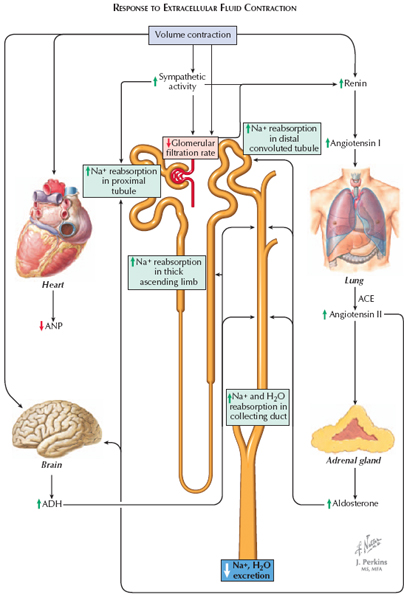RENAL HANDLING OF SODIUM AND CHLORIDE (Continued)
Thick Ascending Limb. In this segment, sodium, chloride, and potassium undergo transcellular reabsorption together on an apical cotransporter (NKCC2). Two chloride ions are transported for each sodium and potassium ion. The basolateral Na+/K+ pumps establish a chemical gradient for sodium that drives this process.
Once in the cell, chloride crosses the basolateral membrane via channels (CLC-NKB) and K+/Cl− transporters (KCC-4). Potassium, in contrast, is recycled back into the lumen through apical ROM-K channels. The net result is a positive charge in the tubular lumen, which promotes the paracellular reabsorption of sodium and other cations.
Although the NHE-3 Na+/H+ exchanger is present in this segment, it makes only a minor contribution to overall sodium reabsorption and is more important for bicarbonate reabsorption (see Plate 3-21).
Distal Convoluted Tubule. In this segment, sodium and chloride undergo transcellular reabsorption together on an apical Na+/Cl− symporter (NCC). The basolateral Na+/K+ pumps establish a chemical gradient for sodium that drives this process. Once in the cell, chloride crosses the basolateral membrane via the CLC-NKB channel.
Connecting Tubule and Collecting Duct. In these segments, sodium undergoes transcellular reabsorption through apical channels (ENaC) located on principal cells. The reabsorption of sodium generates a negative charge in the tubular lumen, which creates a gradient for the paracellular reabsorption of chloride. Although not shown in the illustration, chloride also undergoes trans cellular reabsorption across type B intercalated cells through an apical HCO3−/Cl− exchanger (pendrin) and a basolateral channel (CLC-NKB).

REGULATION OF SODIUM HANDLING
Sodium is the principle osmole of extracellular fluid, and its plasma concentration is modulated by the systems that control the retention or excretion of free water. Thus an increase in sodium concentration results in the retention of free water, whereas a decrease in sodium concentration results in the excretion of free water. This mechanism is controlled by central osmoreceptors, which sense increases in osmolality and respond by promoting feelings of thirst, water-seeking behavior, and the release of antidiuretic hormone (ADH, or vasopressin). Through water consumption and the actions of ADH, which promotes water reabsorption from collecting ducts (see Plate 3-17), free water is added to the extracellular fluid (ECF) until normal osmolality is restored. At this point, osmoreceptor activation ceases.
< div class='tao-gold-member'>




